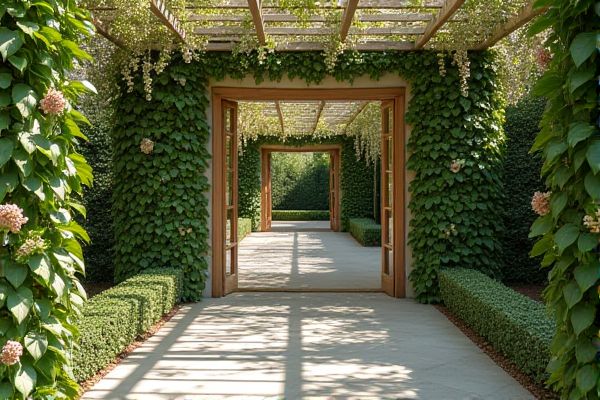
Espalier and trellis trained plants both optimize space and support growth, but espalier involves shaping the plant into a flat, two-dimensional pattern against a surface, while trellis training allows plants to climb freely on a three-dimensional structure. Understanding these differences can enhance your gardening techniques; read on to discover which method suits your garden best.
Table of Comparison
| Aspect | Espalier | Trellis Trained |
|---|---|---|
| Definition | Tree pruned and trained to grow flat against a support | Vine or plant trained on a supporting framework of wires |
| Plant Type | Fruit trees (apple, pear) | Vines and climbing plants (grapes, tomatoes) |
| Growth Style | Flat, two-dimensional growth | Vertical or angled growth guided by wires |
| Space Efficiency | Maximizes space on walls/fences | Optimizes air circulation and sunlight exposure |
| Maintenance | Requires regular pruning and shaping | Needs tying, pruning, and training of vines |
| Purpose | Ornamental and fruit production | Increase yield and ease of harvest |
Introduction to Espalier and Trellis Trained Plants
Espalier and trellis trained plants enhance garden aesthetics by guiding growth along flat surfaces or frameworks. Espalier involves pruning and training trees or shrubs into symmetrical, two-dimensional shapes against walls or fences, optimizing sun exposure and space. Trellis training supports climbing plants on vertical structures, promoting healthy growth and easier maintenance for your garden.
Key Differences Between Espalier and Trellis Techniques
Espalier training involves carefully pruning and tying branches of a tree or shrub to grow flat against a structure, creating a two-dimensional, decorative pattern. Trellis training uses a framework of vertical or angled supports to guide plants' growth, allowing for three-dimensional coverage and easier pruning or harvesting. Espalier is primarily used for fruit trees to maximize sunlight exposure and space, while trellis methods suit climbing plants requiring broad support.
Historical Origins of Espalier and Trellis Training
Espalier training, with origins dating back to ancient Rome and medieval Europe, was historically used to cultivate fruit trees against walls for space efficiency and microclimate benefits. Trellis training, rooted in ancient viticulture practices in the Mediterranean, supports climbing plants and vines, optimizing sunlight exposure and air circulation. Understanding these distinct historical methods enhances your approach to garden design and plant management.
Best Plant Types for Espalier vs Trellis Growing
Espalier training is ideal for fruit trees such as apple, pear, and cherry, which respond well to careful pruning and can produce high yields in limited spaces. Trellis systems suit climbers like grapes, ivy, and clematis, providing vertical support for vigorous vine growth and flexible spreading. Your choice depends on the plant type and desired growth habit, with espalier favoring structured forms and trellis accommodating sprawling or climbing species.
Space and Structural Requirements
Espalier-trained plants require a strong, flat support structure such as a wall or fence to guide their horizontal growth, maximizing space efficiency in narrow gardens. Trellis-trained plants typically need freestanding frameworks or panels, which occupy more ground area but allow three-dimensional growth and easier access for pruning. Both methods optimize vertical space but differ in installation complexity and spatial footprint, impacting garden design choices.
Aesthetic Appeal: Visual Impact Compared
Espalier training creates a striking, formal aesthetic by guiding branches into symmetrical, two-dimensional patterns that enhance architectural features and maximize garden space. Trellis training offers a more natural, vertical growth style, providing a softer visual impact with denser foliage and varied textures. Espaliered plants emphasize precision and structure, while trellised plants focus on lushness and casual elegance.
Growth and Maintenance Considerations
Espalier-trained plants require precise pruning and training to maintain their flat, decorative growth against a surface, promoting better air circulation and sun exposure for fruit production. Trellis-trained plants grow more freely and need less intensive maintenance, but they may require regular tying and occasional pruning to prevent overgrowth and ensure structural support. Your choice depends on the level of effort you're willing to invest in shaping growth and ongoing upkeep.
Yield and Productivity: Which Method Performs Better?
Espalier-trained plants often yield higher productivity per square foot due to their structured pruning, which enhances sunlight exposure and air circulation. Trellis-trained crops can produce abundant fruit but may require more space, reducing overall efficiency in smaller gardens. Your choice hinges on maximizing yield in limited areas, where espalier typically outperforms traditional trellis methods.
Common Challenges and Solutions
Espalier-trained plants often face challenges like restricted air circulation and uneven sunlight exposure, which can lead to fungal diseases; pruning regularly and ensuring proper spacing can help mitigate these issues. Trellis-trained plants may struggle with overgrowth and inadequate support, causing branches to break or grow irregularly; reinforcing the trellis and tying branches securely supports healthy growth. Understanding these common challenges allows you to maintain strong, productive plants with proper care tailored to each training method.
Choosing the Right Training Method for Your Garden
Espalier training shapes plants flat against a wall or fence, maximizing sunlight exposure and saving garden space, making it ideal for small yards or decorative purposes. Trellis training supports plants upright on a freestanding framework, promoting better air circulation and easier harvesting for climbing fruits and vegetables. Understanding the growth habits of your plants and the spatial constraints of your garden helps determine the optimal training method to enhance both aesthetics and yield.
 homyna.com
homyna.com